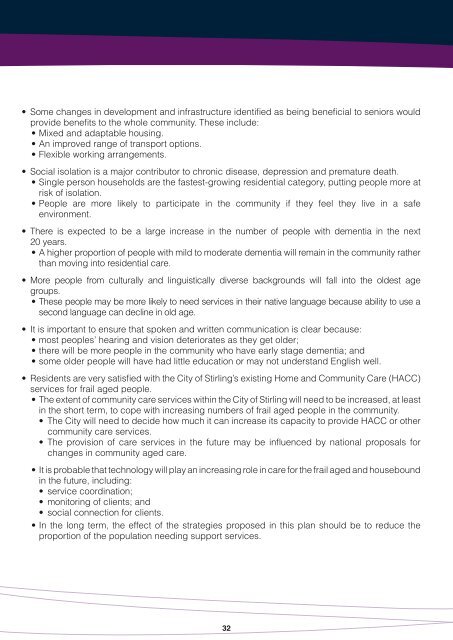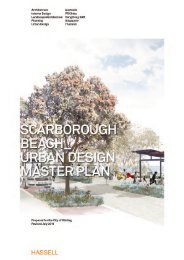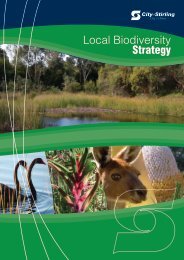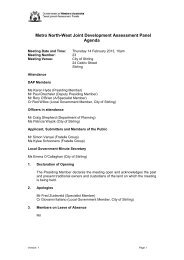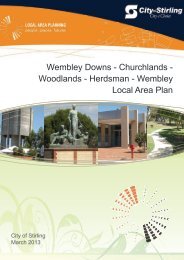Seniors Plan 2007 - City of Stirling - The Western Australian ...
Seniors Plan 2007 - City of Stirling - The Western Australian ...
Seniors Plan 2007 - City of Stirling - The Western Australian ...
You also want an ePaper? Increase the reach of your titles
YUMPU automatically turns print PDFs into web optimized ePapers that Google loves.
• Some changes in development and infrastructure identified as being beneficial to seniors would<br />
provide benefits to the whole community. <strong>The</strong>se include:<br />
• Mixed and adaptable housing.<br />
• An improved range <strong>of</strong> transport options.<br />
• Flexible working arrangements.<br />
• Social isolation is a major contributor to chronic disease, depression and premature death.<br />
• Single person households are the fastest-growing residential category, putting people more at<br />
risk <strong>of</strong> isolation.<br />
• People are more likely to participate in the community if they feel they live in a safe<br />
environment.<br />
• <strong>The</strong>re is expected to be a large increase in the number <strong>of</strong> people with dementia in the next<br />
20 years.<br />
• A higher proportion <strong>of</strong> people with mild to moderate dementia will remain in the community rather<br />
than moving into residential care.<br />
• More people from culturally and linguistically diverse backgrounds will fall into the oldest age<br />
groups.<br />
• <strong>The</strong>se people may be more likely to need services in their native language because ability to use a<br />
second language can decline in old age.<br />
• It is important to ensure that spoken and written communication is clear because:<br />
• most peoples’ hearing and vision deteriorates as they get older;<br />
• there will be more people in the community who have early stage dementia; and<br />
• some older people will have had little education or may not understand English well.<br />
• Residents are very satisfied with the <strong>City</strong> <strong>of</strong> <strong>Stirling</strong>’s existing Home and Community Care (HACC)<br />
services for frail aged people.<br />
• <strong>The</strong> extent <strong>of</strong> community care services within the <strong>City</strong> <strong>of</strong> <strong>Stirling</strong> will need to be increased, at least<br />
in the short term, to cope with increasing numbers <strong>of</strong> frail aged people in the community.<br />
• <strong>The</strong> <strong>City</strong> will need to decide how much it can increase its capacity to provide HACC or other<br />
community care services.<br />
• <strong>The</strong> provision <strong>of</strong> care services in the future may be influenced by national proposals for<br />
changes in community aged care.<br />
• It is probable that technology will play an increasing role in care for the frail aged and housebound<br />
in the future, including:<br />
• service coordination;<br />
• monitoring <strong>of</strong> clients; and<br />
• social connection for clients.<br />
• In the long term, the effect <strong>of</strong> the strategies proposed in this plan should be to reduce the<br />
proportion <strong>of</strong> the population needing support services.<br />
32


